The Human Effect of a Burglary
Home sweet home. A haven filled with cherished memories and a place where we should feel the safest – but what happens when an unwelcome intruder violates the sanctity of our space?
Burglary is a deeply unsettling experience that can shatter the sense of safety we cherish within our homes. The effects of falling victim to burglary are not always confined to the loss of material possessions but can have lasting emotional and psychological effects that often go unnoticed.
To shed light on the impact of burglary on its victims, we conducted a public survey to find out how long it takes people to feel safe in their homes again after being burgled. We also look at which gender is most likely to feel safer and the age group most likely to feel safer at home.
Furthermore, we unveil how people changed their home security, such as opting for a smart home system after a burglary. In addition, we reveal the areas and regions with the most burglaries, the average cost of a burglary, and the average age of victims.
Victims of a home burglary
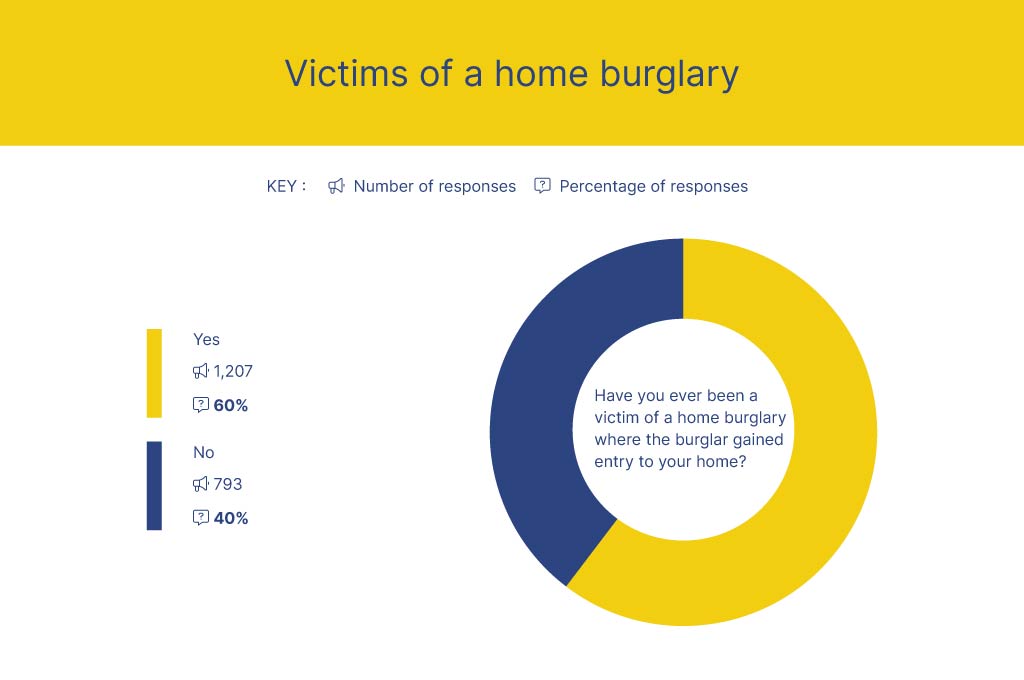
Out of the 2,000 people we asked, almost two-thirds (60%) of respondents stated that they had experienced a home burglary, while under two in five (40%) people responded they have never been burgled.
According to UK burglary statistics, by the end of March 2023, there was a total of 191,490 residential burglaries across England and Wales, equating to 525 homes home burglaries per day on average, which suggests that a house is burgled, on average, every 165 seconds. These shocking statistics highlight the importance of taking the necessary steps to ensure your home and valuables are fully safe and secure.
Actions taken after a burglary
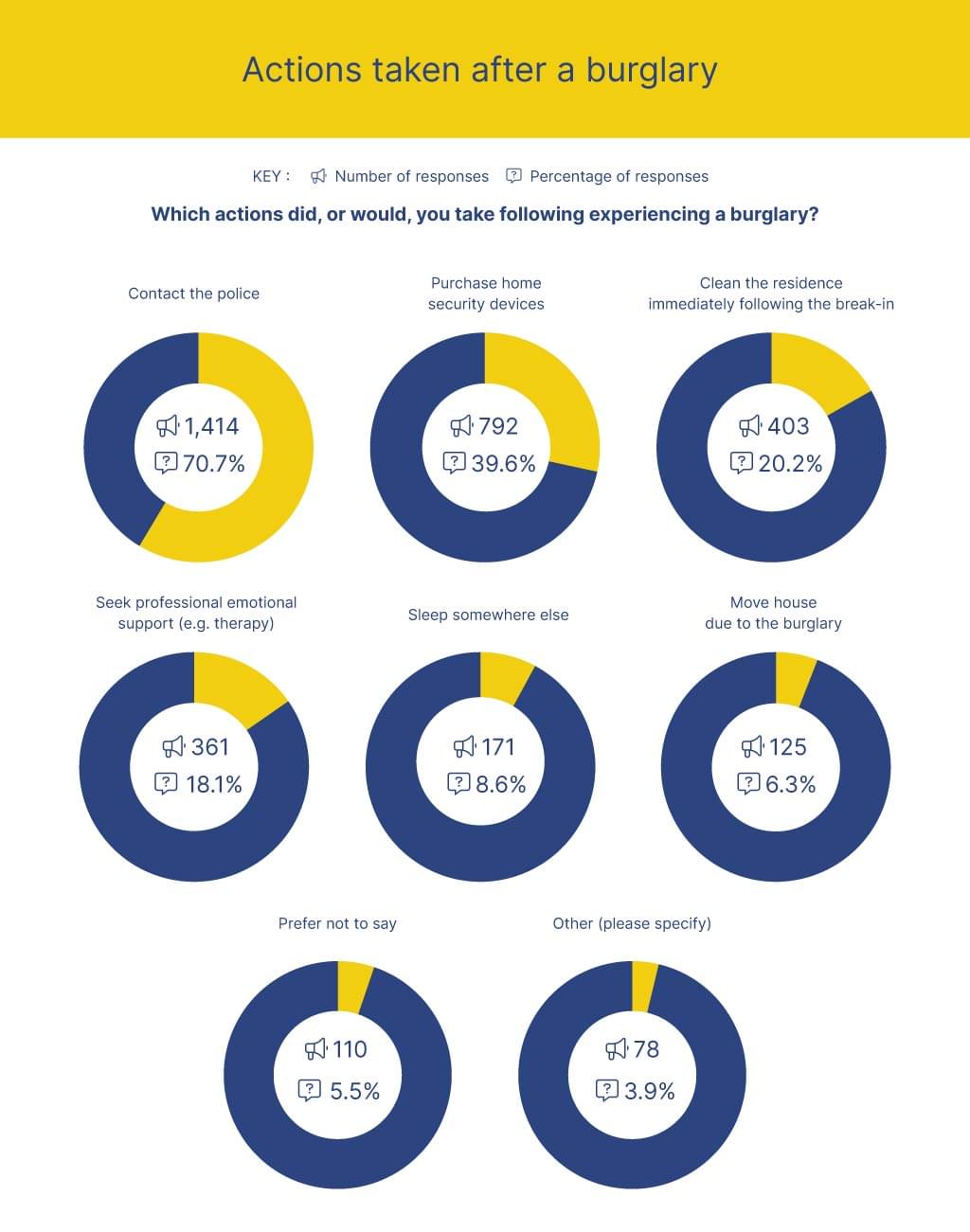
When asked what actions they took after a burglary, over two-thirds (70.7%) of victims stated that they contacted the police. This is important as once a crime is reported, the police can start their investigation and find the necessary evidence to ensure that the unwelcome intruder is held accountable.
Purchasing home security devices followed behind as one of the most common things to do after being burgled, with almost two in five (39.6%) respondents indicating they had security products installed.
Having a monitored, smart home security system installed ensures that in the event of an alarm activation, both you, your keyholders and the police will be notified (if opting for police response). You can also stay in control of your home anytime and anywhere from your phone, giving you peace of mind even when you are not home.
Length of time taken to feel safe at home again
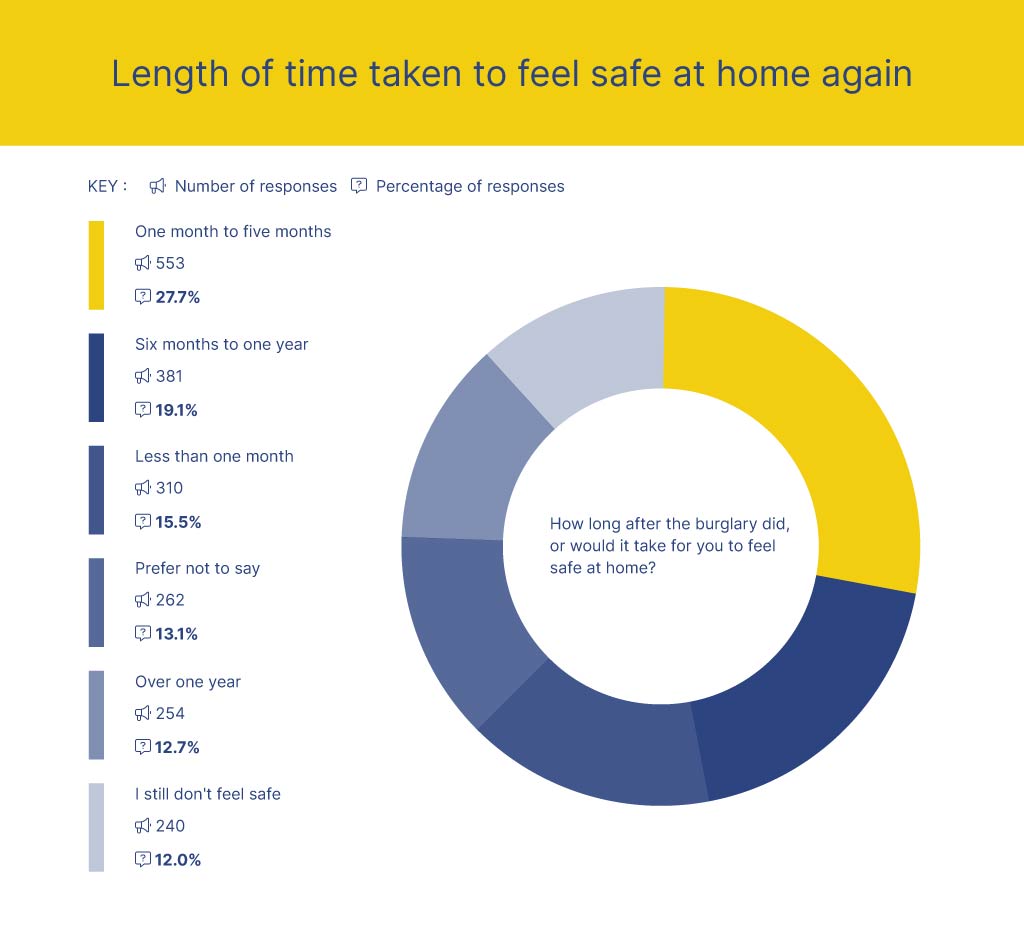
More than a quarter (27.7%) of people admitted that it took them between one to five months, while almost one in five (19.1%) people stated that it took or would take anywhere from six months to a year to feel reassured of their safety at home.
Practical actions can help victims cope with the emotional effects of a burglary, such as installing extra locks and security alarms. Smart plugs also add an extra layer of protection to your security system, as you can connect lights to motion-sensing cameras and video doorbells. This allows you to set rules and timers to turn lights on and off, as well as use your smartphone to turn off/on devices to give the illusion someone is home.
Victim of a home burglary by gender
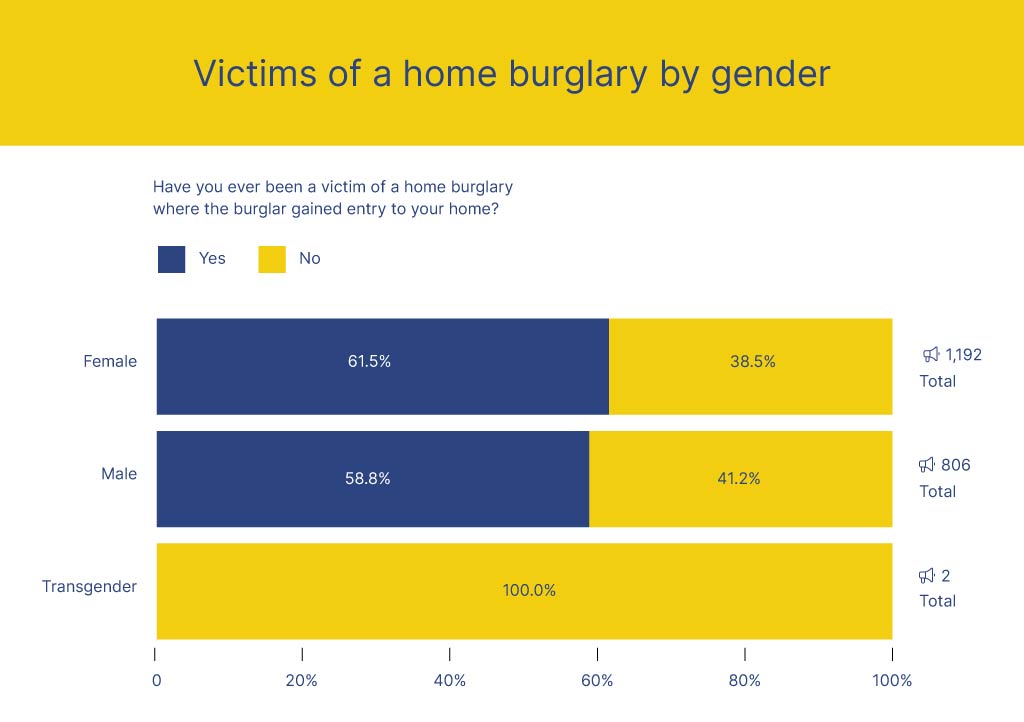
Females are more at risk of being burgled than males, statistics suggest. Compared to men, almost two-thirds (61.5%) of women have been a victim of a home burglary. Over half (58.8%) of males stated that they experienced an unwelcome intruder gain entry into their home.
Whilst this survey gives us a glimpse of which genders are most at risk of experiencing a home burglary, it is important to note that these survey results cannot provide the full picture of people living with others of different genders.
Actions taken after a burglary by gender
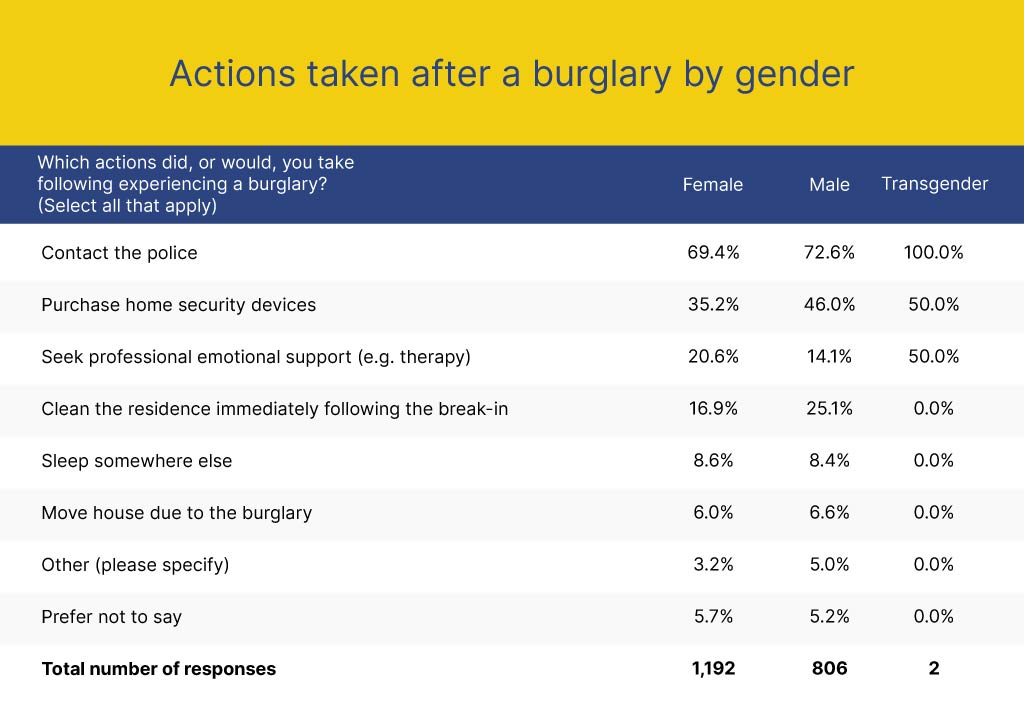
Almost three-quarters of males (72.6%) would or have contacted the police regarding a home break-in, and over two-thirds of females (69.4%) would do the same.
Purchasing home security devices was also one of the most popular actions taken by each gender. However, a quarter (25.1%) of males agreed that cleaning the residence immediately after the break-in was essential, while for females (20.6%) and transgender individuals (50.0%), seeking professional emotional support would be more important.
Which gender is most likely to feel the safest after a home burglary?
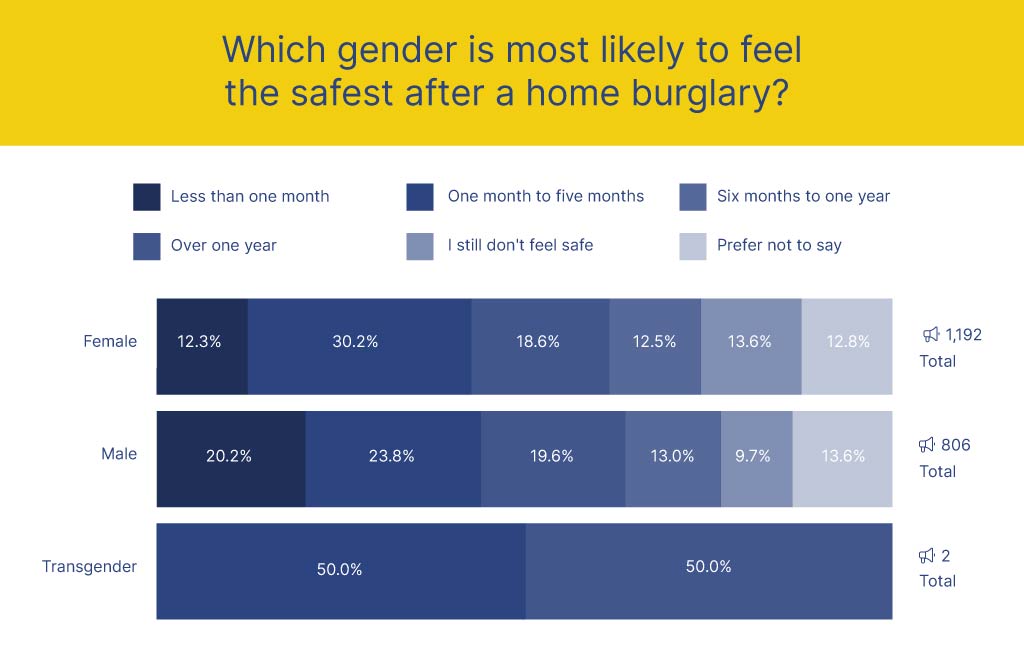
All genders agreed that it would take at least one to five months to be more reassured of their safety while in their own home after experiencing a home break-in. Overall, males are most likely to feel the safest after just less than one month, with a fifth (20.2%) of respondents stating that they would feel safe at home again after a month or less.
On the other hand, both females (30.2%) and transgender individuals (50%) felt that one month to five months was a more realistic timeline to feel safe at home again.
Victims of a home burglary by age
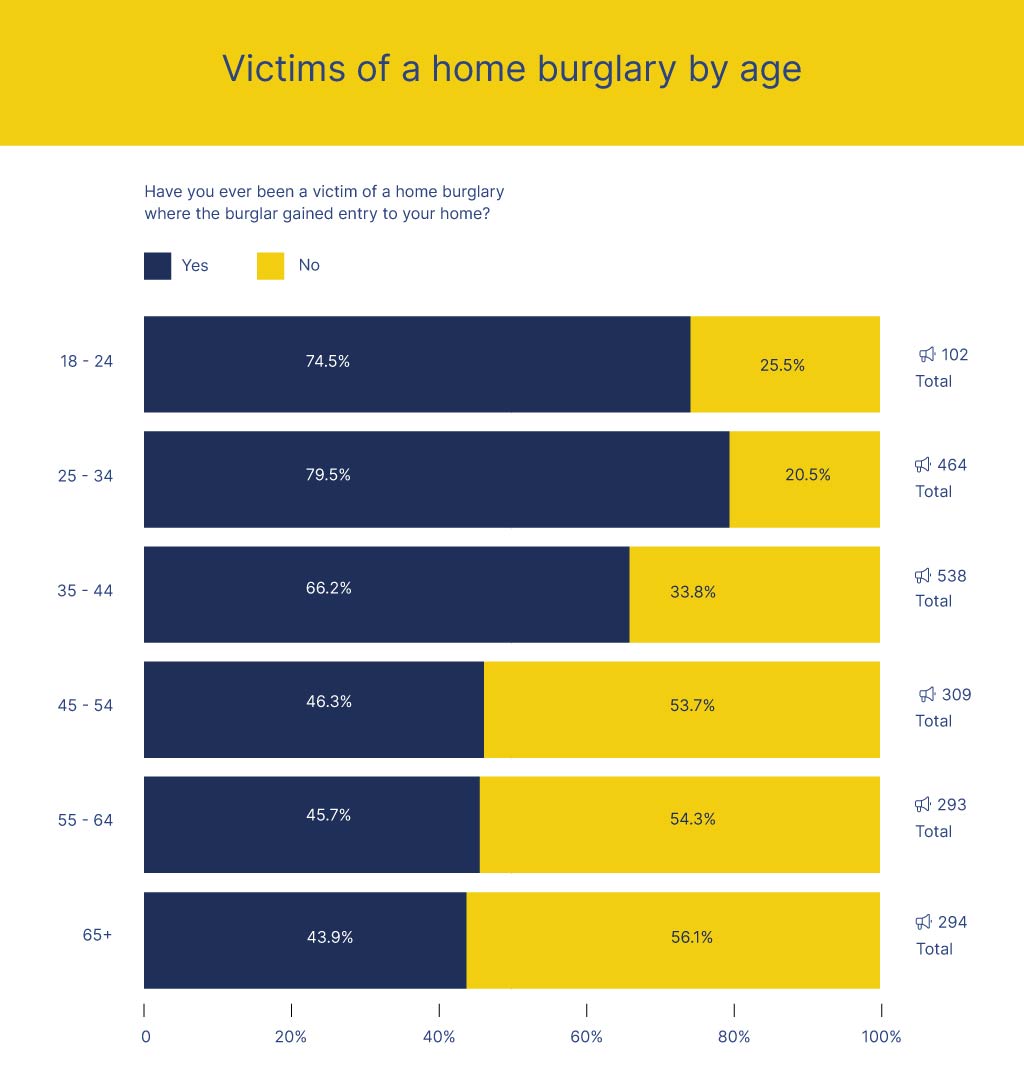
The most at-risk age group of getting burgled is 25 to 34-year-olds. Figures suggest that over three-quarters (79.5%) of people within this age range have fallen victim to a home burglary where the burglar gained entry to their home. This could indicate burglars are targeting young homeowners and students.
Interestingly, when asked what they would do following a burglary, just over a third (34.7%) of this age group said they would purchase home security devices. In comparison, almost half of those aged 55-64 (46.1%) and 65+ (43.2%) said they saw home security as the most important action. These age groups are also the least targeted by burglars, which could suggest home security devices can act as a deterrent.
Those aged between 18-24 years old are the next most likely group to experience a burglary, with almost three-quarters (74.5%) of respondents stating that they were burgled. This age group is also more likely to take out home security measures than all other age groups, with more than half (52.9%) of respondents stating they would purchase home security devices.
Actions taken after a burglary by age
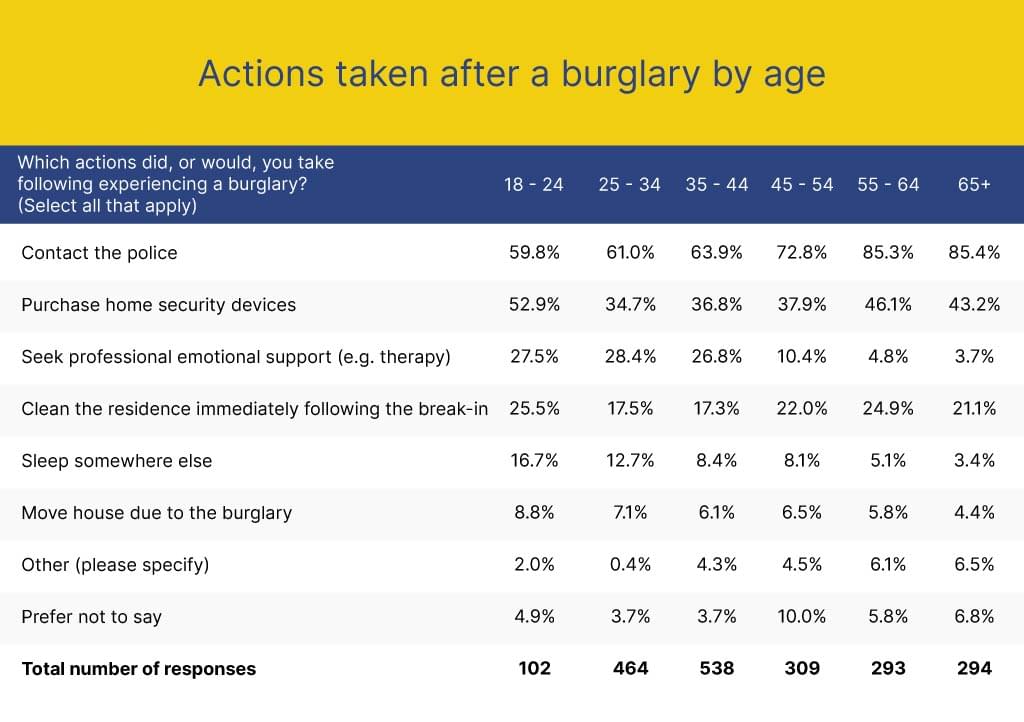
The majority of all age groups agreed that contacting the police was the most crucial action, with over four-fifths of 55 to 64-year-olds and those aged 65+ considering this action. Following contacting the police, purchasing home security was the next most essential action, with over half (52.9%) of the 18 to 24 age group opting for this.
Seeking professional emotional support was particularly more prevalent among the younger age groups, including 18 to 24 (27.5%), 25 to 34 (28.4%) and 35 to 44 (26.8%), while for the older generation cleaning the residence immediately after a break-in was more critical.
Which age group is most likely to feel the safest after a home burglary?
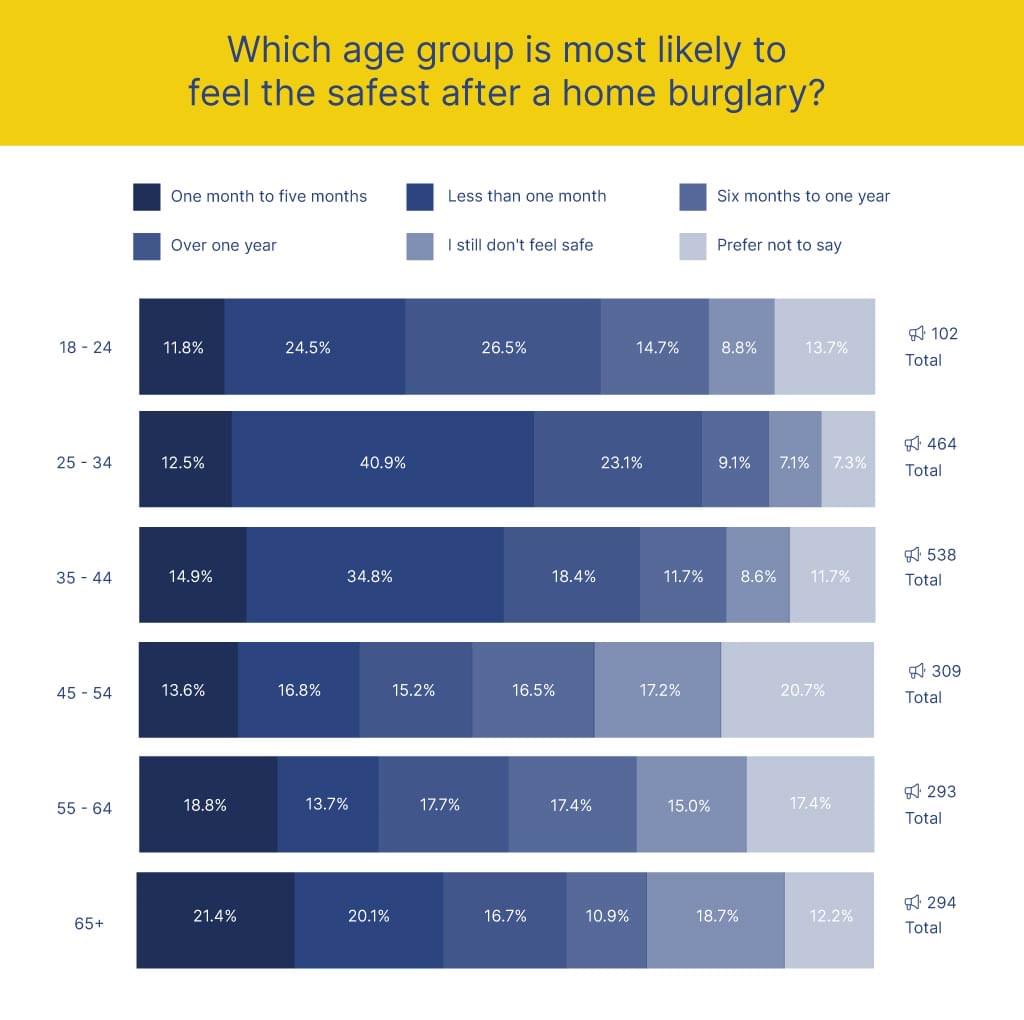
Those aged 25 to 34 (40.9%) and 35 to 44 (34.8%) are most likely to feel safe one to five months after experiencing a residential break-in. Those aged 18 to 24 (26.5%) said they would most likely spend six months to a year recovering from the experience before they feel safe again.
On the other hand, almost one in five (18.8%) people in the 55 to 64 age group and just over one in five (21.4%) of those aged 65+ reported that less than one month was more than enough time to feel safe again after experiencing a home break-in.
Victims of a home burglary by region
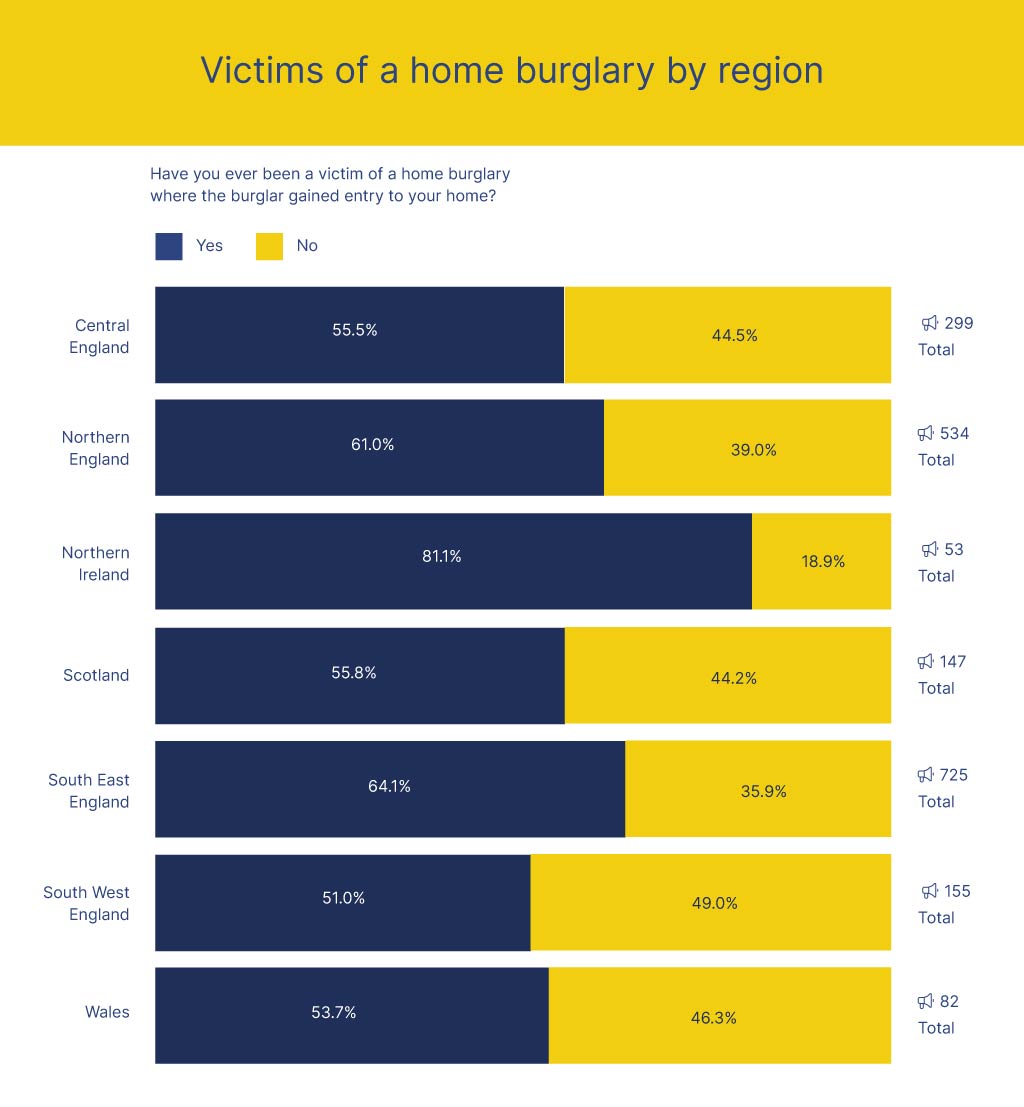
Northern Ireland is the region with the most victims of home burglary, according to our survey, with over four-fifths (81%) of respondents from the region stating that they have experienced a break-in.
Northern England (61%) and South East England, including areas such as Kent and Surrey (64.1%), follow suit, with almost two-thirds of people stating that they have had an unwelcome guest.
This correlates with ONS data, which shows that the North West experienced 9.1 home burglaries per 1,000 households for the year ending March 2023, while the North East experienced 8.9 home burglaries. The South East (5.5) and the South West (4.5) also experienced relatively high household burglary rates.
Actions taken after a burglary by region
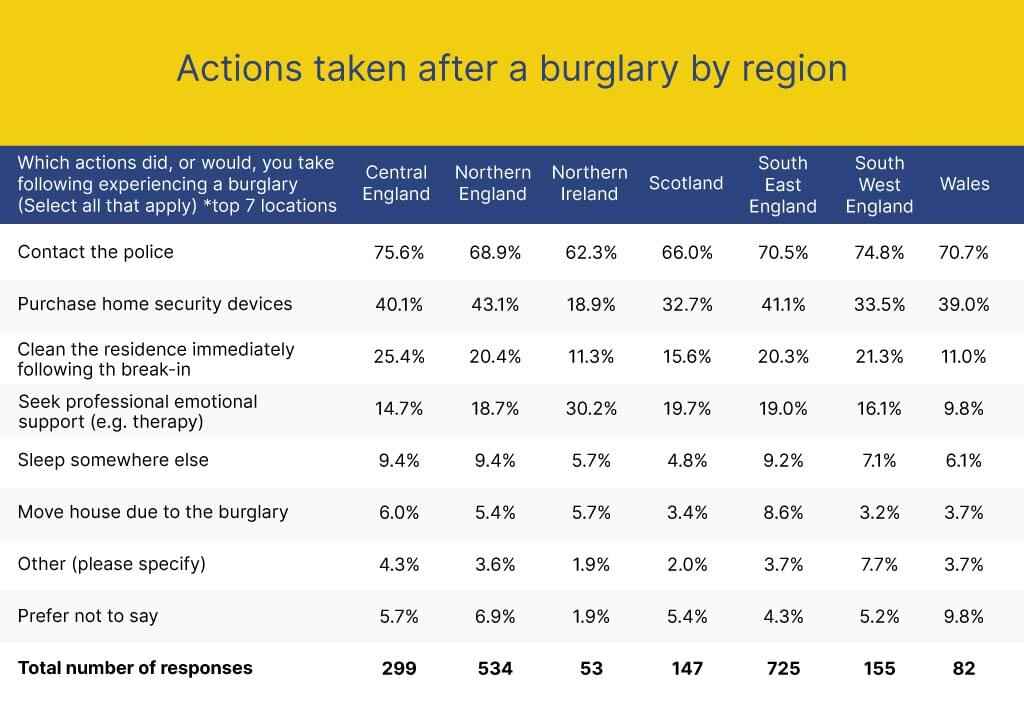
Contacting the police topped the list as the most important action across all regions, particularly in Central England (75.6%), South West England (74.8%) and Wales (70.7%). Interestingly, more people in South England are more likely to contact the police after a home burglary than in the North.
Purchasing home security devices was the second most important action, especially in Northern England (43.1%) and South East England (41.1%). Cleaning up the residence after a break-in has a higher response from regions such as Central England (25.4%), Northern England (20.4%) and South East England (20.3%). Whereas those from Northern Ireland (30.2%) and Scotland (19.7%) prefer to seek professional emotional support such as therapy.
Which regions are most likely to feel the safest after a home burglary?
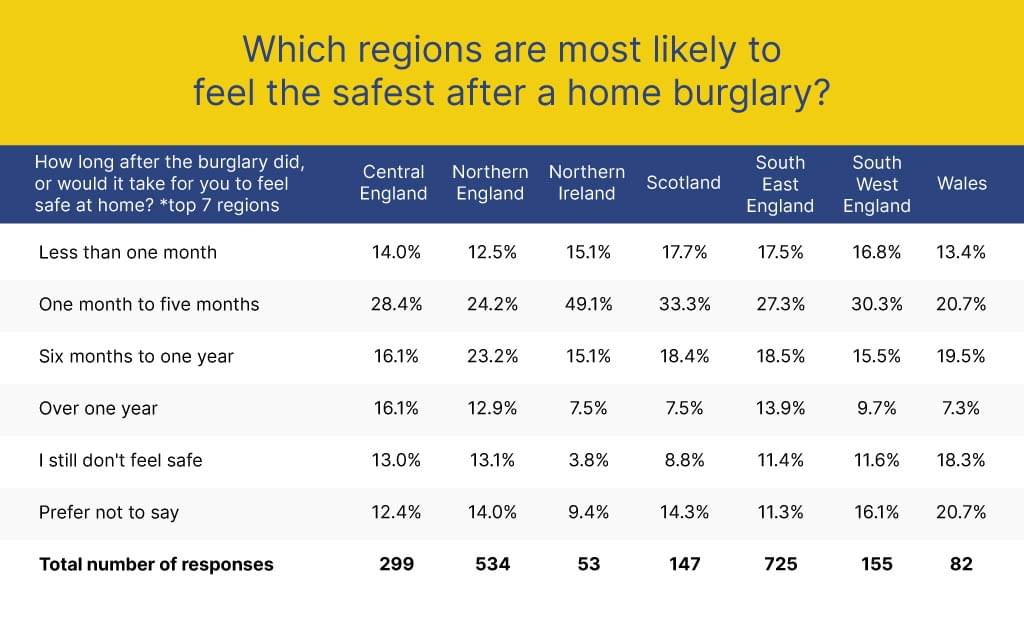
Most respondents from all regions stated that it would likely take them anywhere from one to five months to feel comfortable in their homes again, especially Northern Ireland (49.1%), with almost half of the responses stating this.
Those in regions such as Scotland (17.7%), South East England (17.5%) and South West England (16.8%) have some of the highest responses in the category, expressing that it would take them less than one month to feel safe again in their homes.
Victims of a home burglary by city
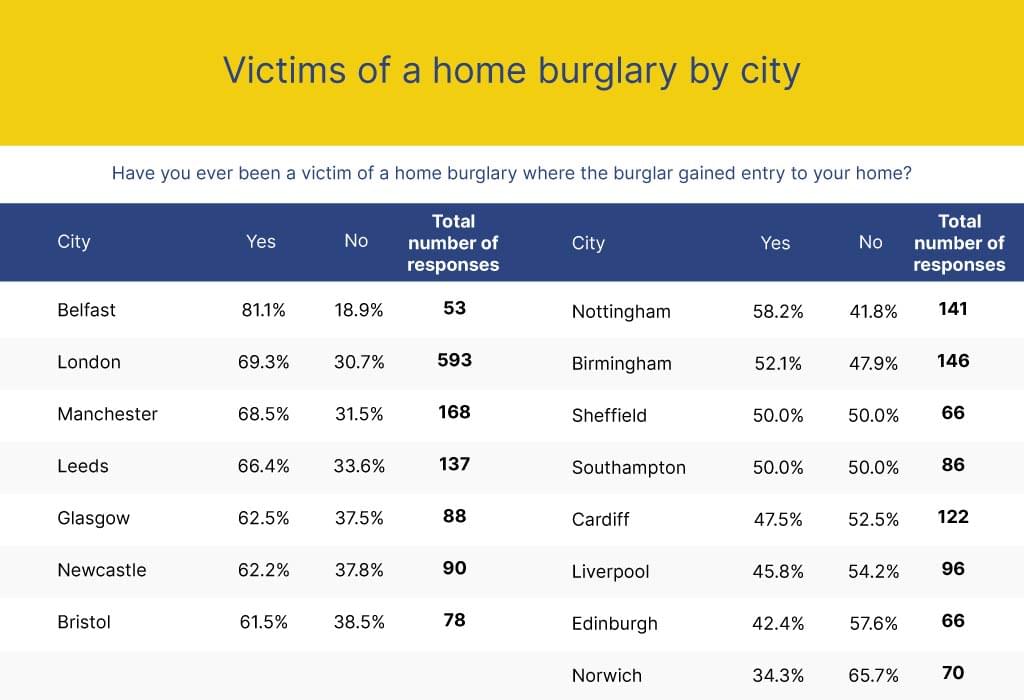
Looking at the cities with the most victims of home burglaries, Belfast has the highest burglary rate, with over four-fifths (80%) of respondents stating that they have had a burglar break into their home.
London has the second highest burglary rate, with nearly 70% of people on our survey stating they have been burgled. This is unsurprising as, according to ONS data, London experienced more burglaries per 1,000 homes than any other region in England and Wales.
Other cities, such as Manchester (68.5%) and Leeds (66.4%), have some of the highest burglary rates, with over two-thirds of residents stating that they had fallen victim to a burglary. According to ONS data, the West Yorkshire and Greater Manchester police areas are among the top five most targeted.
Norwich has the lowest burglary rate, with almost two-thirds (65.7%) of respondents admitting that they have never been burgled. Edinburgh, Liverpool and Cardiff also have low burglary rates, with over 50% of people saying they have never been victims of a home burglary.
Actions taken after a burglary by city
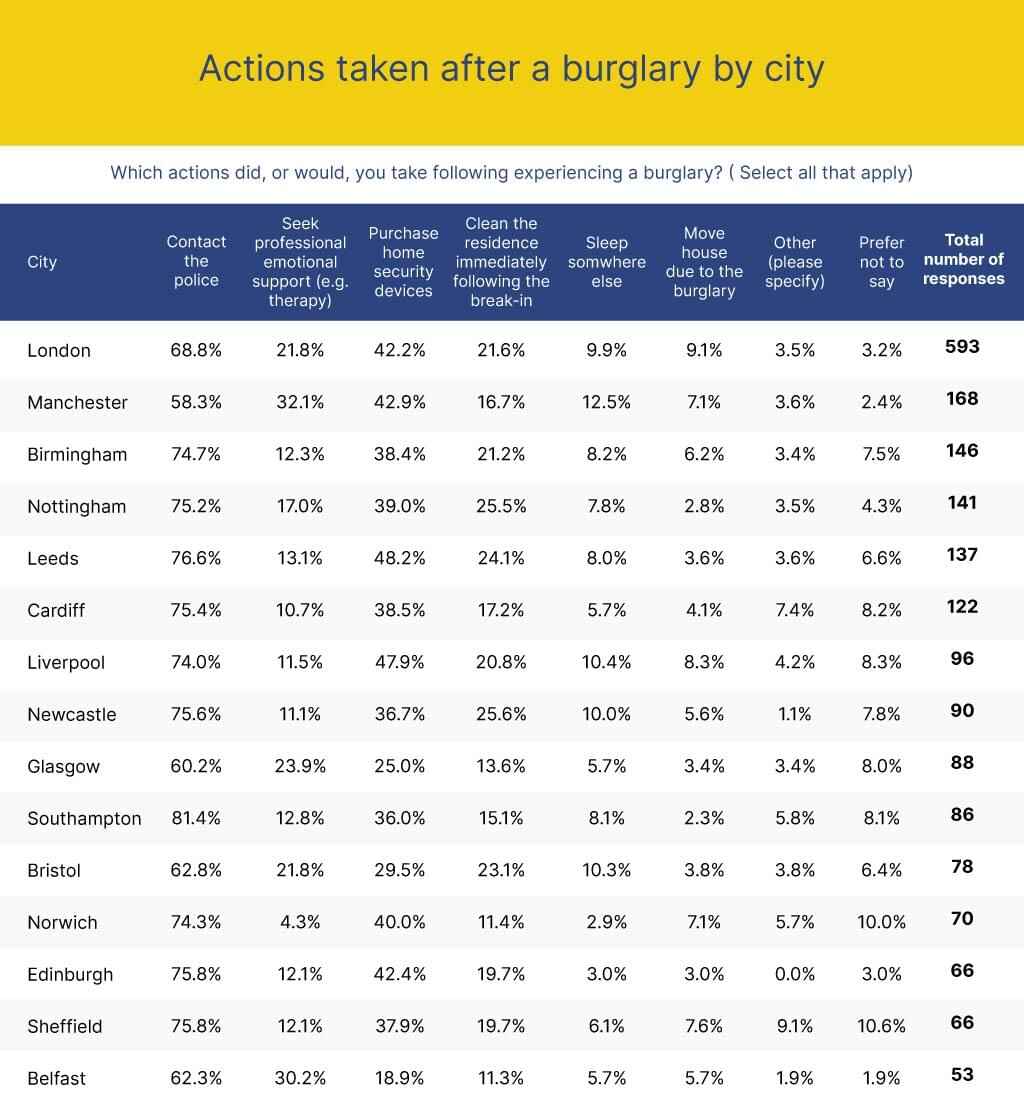
Over half of residents from all cities stated that they would contact the police as a priority, especially Southampton, with more than four in five (80%) people stating that calling the police authorities was the most crucial action.
Purchasing home security devices was also ranked highly across all cities just after contacting the police, highlighting the importance of up-to-date home security measures such as burglar alarms and outdoor cameras.
Several people stated that they would sleep somewhere else, especially in cities such as Manchester (12.5%), Liverpool (10.4%) and Bristol (10.3%). In comparison, people in cities such as London (9.1%) and Liverpool (8.3%) also stated they would most likely move house due to the burglary.
Which cities are most likely to feel the safest after a home burglary?
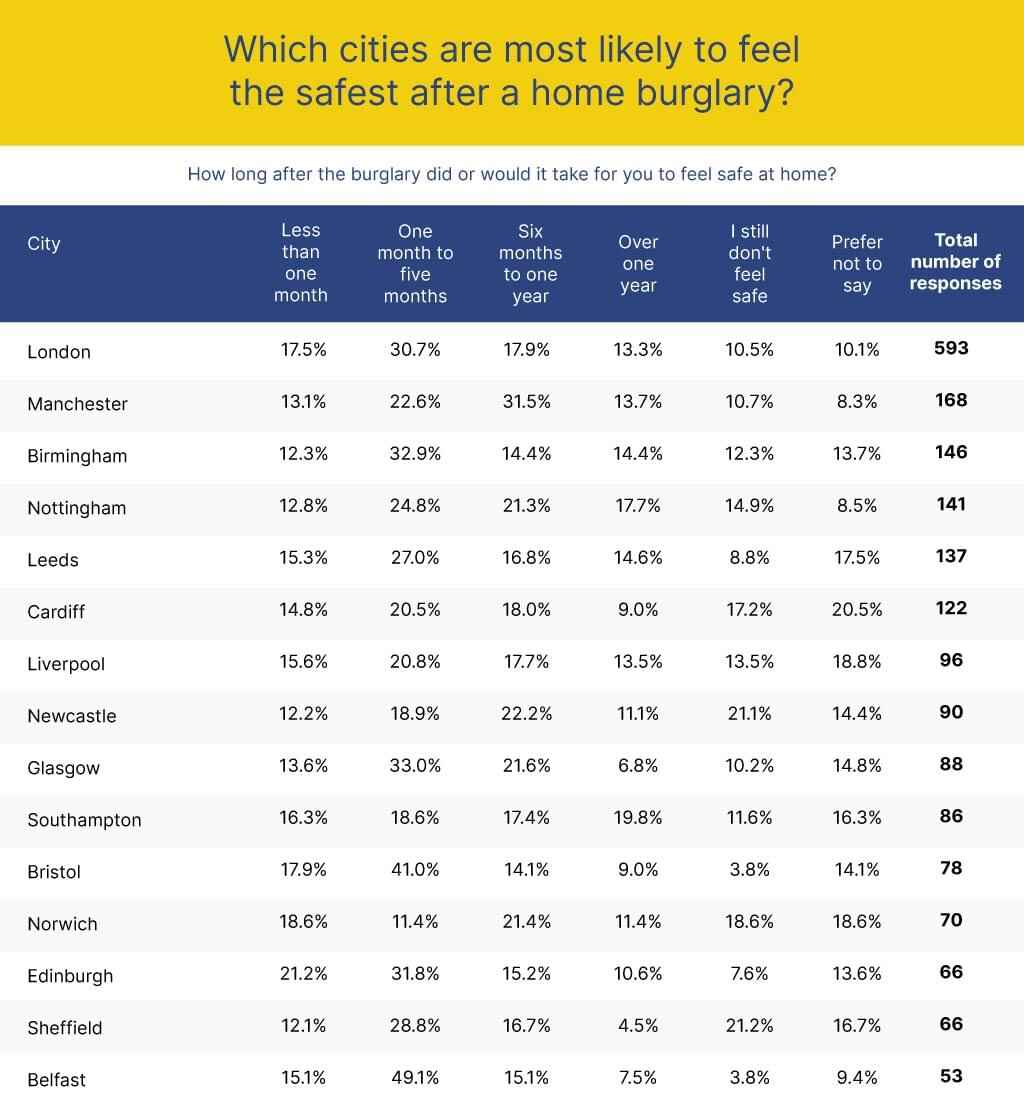
Norwich is the city most likely to feel the safest within less than one month of a home burglary, with almost one in five (18.6%) people stating they would feel safe again in their home less than one month after a break-in. One month to five months had the highest response across most cities, especially Belfast (49.1%), Bristol (41%) and Glasgow (33%).
Regions with the most residential household burglaries
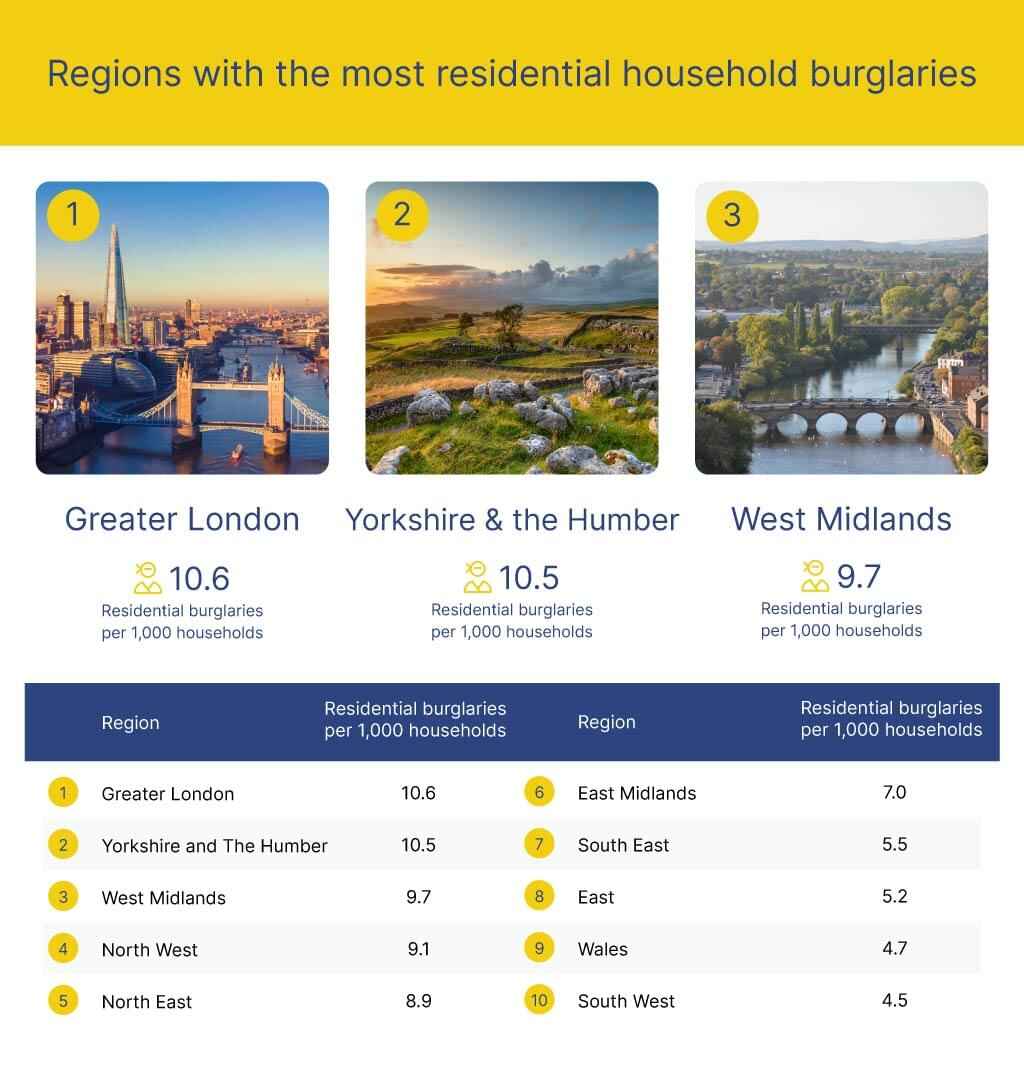
1. Greater London
Residential burglaries per 1,000 households: 10.6
ONS data suggests that Greater London is the region with the most residential burglaries. By the end of March 2023, an estimated 10.6 home burglaries per 1,000 households occurred in the region - The total number of home break-ins in London represents just under 20% of all residential burglaries across England and Wales.
This is unsurprising as data from the BBC implies that 82% of burglaries in London go unsolved. As a result, the Home Office invested in record funding for policing that can be used for neighbourhood patrols, CCTV and alarm systems.1
2. Yorkshire and the Humber
Residential burglaries per 1,000 households: 10.5
Following closely behind is Yorkshire and The Humber, with 10.5 residential burglaries per 1,000 households. By March 2023, the region saw a total of more than 24,000 home burglaries. Despite being one of the areas with the most burglaries, residential burglary in the region was said to have decreased by 12.3% per year between 2011 and 2021. 2
3. West Midlands
Residential burglaries per 1,000 households: 9.7
With approximately 9.7 residential burglaries per 1,000 households, the West Midlands completes the top three. Overall, more than 23,000 residential burglaries took place by March this year. The burglary rates in some parts of the region are relatively higher than in others, with Birmingham being identified as a hotspot.
Areas with the most residential household burglaries
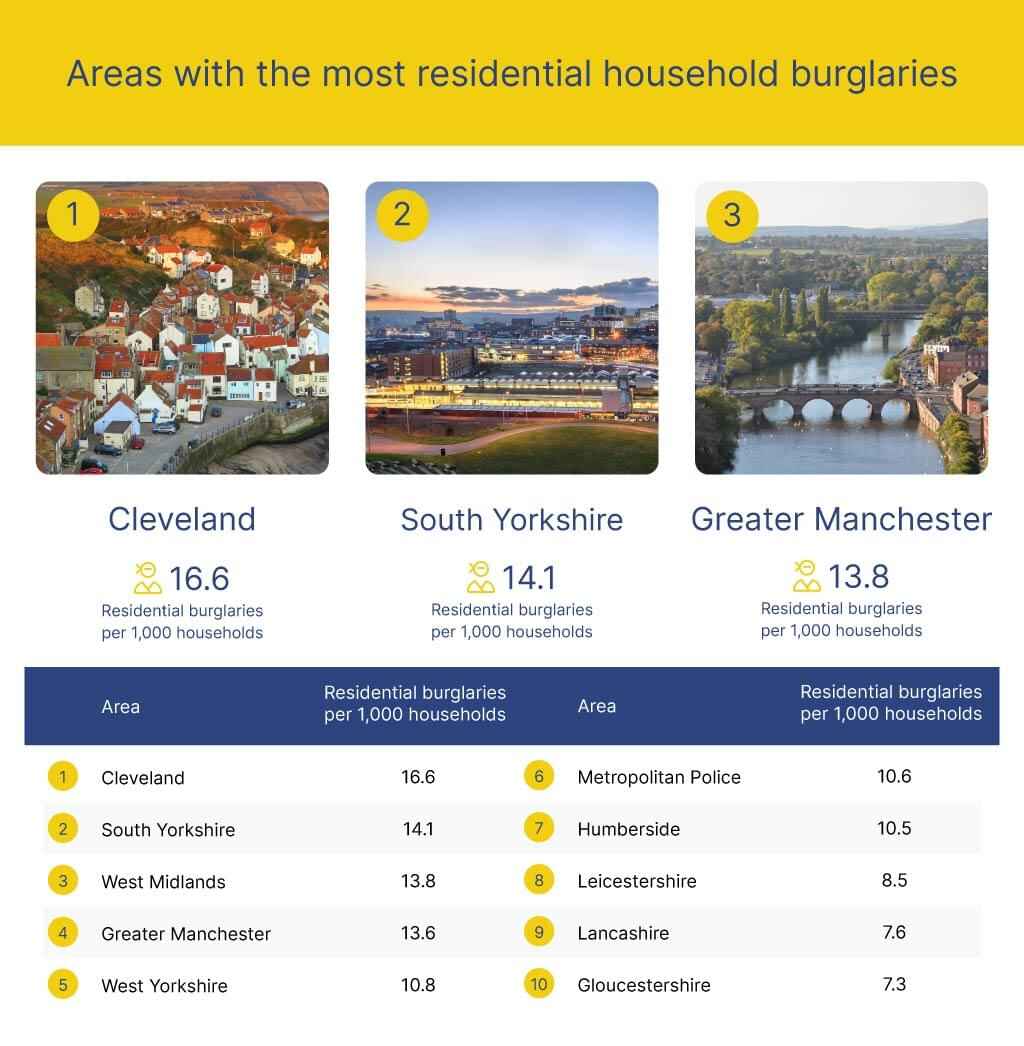
1. Cleveland
Residential burglaries per 1,000 households: 16.6
Regarding the police force areas with the highest number of burglaries, Cleveland tops the list with an average of 16.6 residential burglaries per 1,000 households. As of March this year, the county saw a total of 4,065 residential burglaries occur, a 33% increase from the previous year, which had 3,064 residential burglaries.
Compared to last year’s Burglary Report, Cleveland has seen a significant spike in household burglaries, going from fourth place to first in just one year.
2. South Yorkshire
Residential burglaries per 1,000 households: 14.1
Still ranking in second place like the previous year, South Yorkshire also has a high rate of break-ins, with over 14 residential burglaries per 1,000 households. South Yorkshire experienced 8,464 residential burglaries by the end of March 2023. Despite a 6% increase in burglaries across the country, research suggests that only 5% of all South Yorkshire burglaries have resulted in the suspect being charged or summonsed.3
3. West Midlands
Residential burglaries per 1,000 households: 13.8
Much like South Yorkshire, the West Midlands remains in third place compared to last year, going from 13.2 to 13.8 residential burglaries per 1,000 households. This not only highlights a 5% increase in household burglaries but there were more than 15,797 residential burglaries in the area as of March 2023.
The cost of a burglary
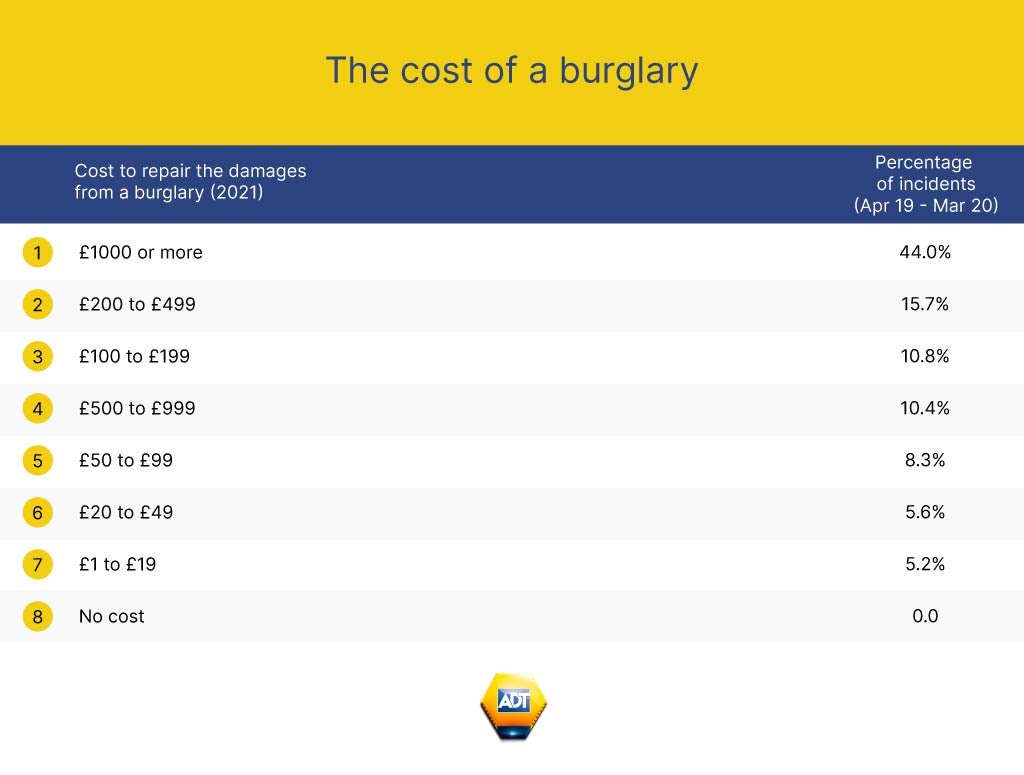
The average cost of a burglary in England and Wales is an estimated £2,856. Over two-fifths of incidents (44%) resulted in £1000 or more worth of stolen items. This is significantly higher than incidents that cost less than £500, which was the second highest category with 15.7%.
What to do if you have been burgled
Unfortunately, if you ever come home to find it broken into, it is important that you call the police first and foremost. 101 is the non-emergency number you can call the police to file a report. It is also crucial that you secure your home in order to prevent this from happening again. Adding deadlocks, cameras, and security alarms can make it harder for intruders to break in.
At ADT, we know the importance of feeling safe and secure in your home again as quickly as possible. That’s why we offer same-day appointments and installations where possible. We’re here to help put your mind at ease with 24/7 support and a nationwide team of trained engineers at hand.
Methodology
To find out the regions and areas with the most burglaries, we looked at the latest figures for Crime in England and Wales: Police Force Area. Using the data for the total number of burglaries for the year ending March 2023, we calculated the number of residential burglaries per 1,000 households. Data collection for this was completed on 28/09/2023.
Data for the mean average cost of a burglary was sourced from ONS Nature of Crime: Burglary and is based on the UK burglary statistics. Data collection for this was completed on 25/09/2023.
We also conducted a public survey with 2,000 people to determine the impact of burglary on its victims. Using this survey, we collected data based on how long it took people to feel safe again in their homes, looking at factors such as gender, age, region and city. We also gathered data on people’s home security habits. Please note that the Channel Islands and the Isle of Man were not included in the region section due to having a small sample.
1 https://www.bbc.co.uk/news/uk-england-london-66304969
2 https://www.varbes.com/crime/yorkshire-and-the-humber-crime
3 https://www.shefflibdems.org.uk/news/article/south-yorkshire-burglaries#:~:text=The%20figures%2C%20from%20official%20Home,suspect%20being%20charged%20or%20summonsed